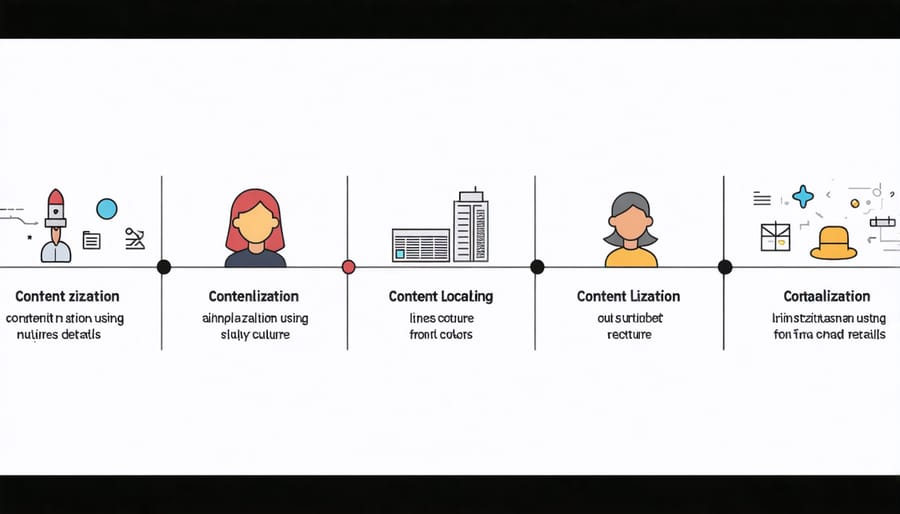Global SEO That Actually Drives International Sales (Proven Strategy)

Expanding your digital presence across international markets demands a sophisticated approach to SEO best practices tailored for global audiences. Research shows that 76% of online consumers prefer purchasing products with information in their native language, making international SEO strategy crucial for business growth.
Effective global SEO implementation requires three core components: technical infrastructure that supports multiple languages and regions, culturally-adapted content that resonates with local audiences, and market-specific keyword research that captures regional search behavior. Companies that successfully execute these elements typically see a 70-150% increase in organic traffic from international markets within the first year.
The challenge isn’t just translating content—it’s building a comprehensive digital ecosystem that serves diverse audiences while maintaining brand consistency. Whether you’re targeting emerging markets in Southeast Asia or established European economies, your international SEO strategy must balance global brand guidelines with local market nuances to drive meaningful engagement and conversion.
This systematic approach to international SEO transforms your digital presence from a single-market operation into a scalable, multi-market powerhouse that captures global opportunities while minimizing resource waste and maximizing ROI. By focusing on data-driven decision-making and market-specific optimization, businesses can create sustainable growth paths in international markets while maintaining their competitive edge in existing territories.
Why Traditional SEO Falls Short in Global Markets
Many businesses make the costly mistake of simply translating their domestic SEO strategy and applying it to international markets. This approach typically falls short because it fails to account for crucial cultural, linguistic, and market-specific nuances that significantly impact search behavior and user intent across different regions.
One major pitfall is the literal translation of keywords without considering local search patterns. For instance, while Americans might search for “cell phone plans,” British users are more likely to look for “mobile tariffs.” These subtle differences in terminology can dramatically affect your visibility in local search results.
Technical oversights also commonly plague international SEO efforts. Many organizations neglect proper hreflang implementation, leading to confusion among search engines about which version of content should be served to users in different locations. Similarly, failing to implement country-specific domains or subdomains correctly can result in poor search engine rankings and reduced local visibility.
Content localization presents another significant challenge. Simply translating existing content without adapting it to local cultural contexts, preferences, and buying behaviors often results in poor engagement and conversion rates. This includes everything from payment preferences to social proof elements that resonate with local audiences.
Local competition analysis is frequently overlooked when businesses expand internationally. What works in your home market might be completely ineffective in another country where competitors have already established strong digital presences with locally-optimized strategies.
Search engine preferences vary significantly by region as well. While Google dominates in many markets, platforms like Yandex in Russia and Baidu in China require entirely different optimization approaches. Many businesses fail to adapt their strategies to these local search engines’ unique algorithms and ranking factors.
Time zones and seasonal differences also impact traditional SEO strategies. Content scheduling, promotional campaigns, and customer service hours need careful consideration to align with local market behaviors and expectations.
By understanding these limitations of traditional SEO approaches, businesses can better prepare for the complexities of international market expansion and develop more effective, localized strategies.

Technical Foundation for International SEO Success
International URL Structure and Hreflang Implementation
Proper URL structure and hreflang implementation are crucial elements for successful international SEO. When expanding globally, you’ll need to choose between three main URL structures: ccTLDs (country-specific domains like .fr or .de), subdomains (fr.website.com), or subdirectories (website.com/fr/).
Each approach has its merits: ccTLDs provide the strongest geo-targeting signals but require more resources to maintain, subdomains offer a good balance of targeting and management, while subdirectories are easiest to manage and maintain SEO authority. For most businesses, subdirectories provide the best balance of benefits and practical implementation.
To properly implement hreflang tags, follow these essential guidelines:
– Include self-referential hreflang tags for each language version
– Use ISO language codes (e.g., “en-US” for American English)
– Implement reciprocal hreflang tags across all alternate versions
– Place hreflang tags in the HTML head section or XML sitemap
Here’s a basic example of correct hreflang implementation:
Remember to include the x-default tag to specify which version should be shown when no language version matches the user’s location or preferences. Regular auditing of your hreflang implementation is essential to catch and fix any errors that could impact your international SEO performance.
For content management efficiency, consider implementing a system that automatically generates the correct URL structure and hreflang tags based on your content organization.
Global Server Configuration and Geotargeting
Proper server configuration plays a crucial role in delivering the right content to users across different geographical locations. Start by implementing a robust Content Delivery Network (CDN) to ensure fast loading times worldwide. Your CDN should be configured to serve content from servers closest to your target users, reducing latency and improving overall user experience.
When setting up your hosting infrastructure, consider using country-code top-level domains (ccTLDs) or subdirectories for different regions. While ccTLDs provide the strongest geo-targeting signals, they require more resources to maintain. Subdirectories (like example.com/uk/) offer a more manageable alternative while still maintaining clear technical SEO requirements.
Implement proper hreflang tags to indicate language variations of your content. These tags help search engines understand which version of your page should be shown to users in specific regions. Configure your server to handle IP-based redirection carefully, ensuring that search engine crawlers can still access all versions of your content.
Set up regional hosting where necessary, especially for markets with strict data regulations or where local hosting significantly impacts performance. Use geolocation databases to accurately detect user locations and serve appropriate content, but always provide manual language selection options for users.
Remember to configure your robots.txt file for each regional version of your site and implement proper canonical tags to prevent duplicate content issues across different regional versions. Regular monitoring of server response times and accessibility from different global locations will help maintain optimal performance for all users.
Content Localization That Converts
Cultural Keyword Research and Mapping
Cultural keyword research and mapping is a crucial component of international SEO that goes beyond simple translation. Understanding how your target audience searches in different markets requires a systematic approach to identify and analyze local search behaviors.
Start by creating a seed list of your primary keywords in your source language. Use specialized tools like Google’s Global Market Finder or local search engines’ keyword planners to understand search volumes and competition levels in your target markets. Remember that direct translations often miss the mark – people in different countries may use entirely different terms to search for the same products or services.
Consider these key aspects when conducting cultural keyword research:
1. Local language variations and dialects
2. Regional preferences and colloquialisms
3. Cultural context and sensitivities
4. Seasonal and temporal differences
5. Local competitor analysis
Create a comprehensive keyword mapping document that includes:
– Original keywords
– Market-specific variations
– Search volume by region
– User intent signals
– Cultural relevance scores
– Competition levels
To ensure accuracy, work with native speakers or local market experts who can validate your keyword selections. They can provide insights into nuances that automated tools might miss and help identify culturally inappropriate terms or potentially offensive translations.
Use heat mapping tools to visualize search patterns across different regions and identify opportunities in specific markets. This data can help prioritize your content creation efforts and inform your international targeting strategy.
Remember to regularly update your keyword maps as search behaviors evolve and new trends emerge in different markets. Set up monitoring systems to track changes in search patterns and adjust your strategy accordingly. This dynamic approach ensures your international SEO efforts remain relevant and effective across all target markets.
Document your findings in a centralized database that can be easily accessed and updated by team members across different regions, maintaining consistency in your global SEO approach while allowing for necessary local adaptations.

Local Content Optimization Framework
Successful international SEO requires a systematic approach to adapting your content optimization strategies for different markets while maintaining your core SEO value. Here’s a framework to help you optimize your local content effectively:
Start by conducting thorough keyword research in each target market. Remember that direct translations often miss the mark – instead, focus on understanding how local audiences actually search for your products or services. Use native speakers to validate your keyword selections and ensure they align with local search intent.
Create a content mapping system that identifies which pieces need localization versus translation. Some content may require complete reconstruction to resonate with local audiences, while other pieces might only need minor adjustments. Prioritize your most valuable content first, typically your main service pages and top-performing blog posts.
Implement a hub-and-spoke model for content organization. Your main website serves as the hub, with localized versions acting as spokes. This structure helps maintain consistent branding while allowing for market-specific adaptations. Each local version should have:
– Locally optimized meta titles and descriptions
– Market-specific keyword targeting
– Culturally appropriate images and media
– Localized calls-to-action
– Proper hreflang tag implementation
Establish a quality control process that includes native speaker review, technical SEO validation, and regular performance monitoring. This ensures your localized content maintains both linguistic accuracy and search engine optimization effectiveness.
Finally, create a feedback loop system that tracks performance metrics across different markets. This allows you to identify successful localization patterns and apply them to future content adaptations. Regular analysis of user engagement, conversion rates, and search rankings will help refine your approach over time.

Market-Specific Link Building
Building authority in different international markets requires a tailored approach that goes beyond simple translation of existing link-building strategies. Success depends on understanding the unique characteristics of each target market and developing region-specific relationships.
Start by identifying authoritative websites and influencers in each target market. Local business directories, industry associations, and region-specific professional networks often carry significant weight in their respective markets. Focus on local market targeting through partnerships with established organizations that already have credibility in your target regions.
Consider these market-specific link building strategies:
1. Local Content Partnerships
– Collaborate with local content creators and industry experts
– Create market-specific case studies featuring local businesses
– Develop region-specific resources and tools
2. Regional Press Outreach
– Build relationships with local journalists and publications
– Share market-relevant news and developments
– Participate in local industry events and conferences
3. Cultural Content Adaptation
– Adjust content formats to match local preferences
– Address region-specific pain points and challenges
– Reference local examples and success stories
Remember to focus on quality over quantity when building links in new markets. A few high-authority links from respected local sources often carry more weight than numerous low-quality backlinks. Monitor local competitors to understand which sources they’re leveraging and identify opportunities for similar partnerships.
Implementation tips:
– Research local link-building customs and expectations
– Use native speakers for outreach communications
– Leverage social proof from existing international presence
– Monitor regional algorithm updates and SEO guidelines
– Track market-specific metrics separately
Avoid common pitfalls such as using automated outreach templates across different markets or ignoring local business etiquette. Each market requires a unique approach, and what works in one region may not be effective in another.
Maintain detailed documentation of your link-building efforts in each market, including:
– Successful outreach methods
– Response rates by region
– Most effective content types
– Key relationship metrics
– ROI per market
By taking a systematic, market-specific approach to link building, you’ll establish stronger authority signals in each target region while maintaining authentic connections with local audiences.
Measuring International SEO Performance
Tracking the success of your international SEO efforts requires a comprehensive approach to measuring SEO performance across different markets. Start by monitoring these essential metrics:
1. Market-Specific Rankings: Track your keyword positions separately for each target country using location-specific tracking tools like Ahrefs or SEMrush with country filtering enabled.
2. Geographic Search Console Data: Analyze Google Search Console data by country to understand impression and click patterns from different regions, helping identify market-specific opportunities and challenges.
3. Local Engagement Metrics:
– Time on site by country
– Bounce rates for different language versions
– Page depth for international visitors
– Conversion rates per region
4. Technical Performance Indicators:
– hreflang tag implementation accuracy
– International site structure effectiveness
– Mobile performance across regions
– Page load times in different locations
Popular tools for international SEO monitoring include:
– Google Analytics (with geographic segmentation)
– BrightEdge
– Moz Pro
– ContentKing
– DeepCrawl
Create custom dashboards that combine these metrics for each target market, allowing you to:
– Compare performance across regions
– Identify successful market-specific strategies
– Spot technical issues affecting specific locations
– Track ROI for different international segments
Regular reporting should include:
– Monthly performance trends by country
– Language-specific content effectiveness
– Regional ranking improvements
– Local competitor analysis updates
Set market-specific KPIs and benchmark them against local competitors rather than applying universal standards. This approach ensures you’re measuring success within the context of each market’s unique characteristics and competitive landscape.
Remember to consider seasonal trends and cultural events when analyzing performance data, as these factors can significantly impact regional search behavior and engagement patterns.

Successfully implementing an international SEO strategy requires careful planning, continuous monitoring, and consistent execution. Start by conducting thorough market research and competitor analysis in your target regions. Then, focus on creating a robust technical foundation through proper hreflang implementation, URL structure optimization, and server configuration.
Prioritize content localization over simple translation, ensuring your message resonates with local audiences while maintaining brand consistency. Develop region-specific keyword strategies and create high-quality, culturally relevant content that addresses local search intent.
Build a systematic approach to link building in each target market, focusing on acquiring authoritative local backlinks. Regularly monitor your performance using country-specific analytics and adjust your strategy based on data-driven insights.
Remember to stay compliant with local regulations and maintain clear communication channels with regional teams or partners. Set realistic timelines and allocate adequate resources for each market entry. By following these steps and maintaining flexibility to adapt to changing market conditions, you’ll be well-positioned to achieve international SEO success and drive sustainable global growth for your business.
Leave a Reply